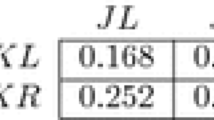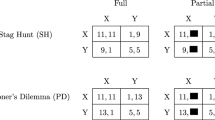Abstract
We define feasible, posterior individually rational solutions for two-person Bayesian games with a single informed player. Such a solution can be achieved by direct signalling from the informed player and requires approval of both players after the signal has been sent. Without further assumptions on the Bayesian game, a solution does not necessarily exist. We show that, if the uninformed player has a “uniform punishment strategy” against the informed one, the existence of a solution follows from the existence of Nash equilibrium in infinitely repeated games with lack of information on one side. We also consider the extension of the result when both players have private information.
Similar content being viewed by others
Notes
For any finite set E, \(\Delta (E)\) denotes the set of probability distributions over E.
The word “solution” may look too strong and is just used for convenience. As will become clear below, we do not make a list of all properties that a solution should satisfy but concentrate on two of them.
The properties detailed below are well identified in Sorin (2002).
The index 1 in \(f_{1}(\cdot )\) is for “one-shot”.
As for the informed player, the index 1 in \(g_{1}(\cdot )\) is for “one-shot”.
For simplicity, we just refer to “Nash equilibrium,” but given the Bayesian game behind the noncooperative game designed for implementation, we might as well use the terminology “Bayesian Nash equilibrium.” Except in Sect. 4.2, we do not impose any refinement.
We thank the referee for suggesting the game \(\Gamma (p)\), which does not depend on the joint decision mapping \(\chi \).
If \(\chi (s^{\prime })=\chi (s^{\prime \prime })\), \(s^{\prime }\) and \( s^{\prime \prime }\) can be merged into a single signal s, such that \(\mu (s\mid k)=\mu (s^{\prime }\mid k)+\mu (s^{\prime \prime }\mid k)\). Incentive compatibility and individual rationality for player 1 are still satisfied. Individual rationality for player 2 follows from the facts that the posterior \(p_{s}\) is a convex combination of \(p_{s^{\prime }}\) and \( p_{s^{\prime \prime }}\) and that \(g_{1}\) is convex.
As soon as there is a mediator, the revelation principle applies and without loss of generality, player 1’s possible signals are just his possible types.
Nonemptiness of \(\mathcal {M}\left[ B(p)\right] \) can also be checked directly, since a mediated solution is defined by linear inequalities. Myerson starts by defining \(\mathcal {M}\left[ B(p)\right] \) but goes on by imposing further requirements on cooperative solutions.
In the context of \(B_{\infty }(p)\), a correlated strategy in \(\Delta (A)\) is interpreted as a limit frequency of moves.
As illustrated by Example 2, the first inequality can be strict for some \(q\in \Delta (K)\). If player 1 cannot make use of his information, the “uniform punishment strategy” \(\tau ^{*}\) of player 2 is not necessarily the worst punishment of player 2 against player 1.
Since values are private and utility functions are linear, a player only cares about his own type and the expected distribution over actions.
The undiscounted infinitely repeated version of the model of Sect. 3.2.2. (namely, lack of information on one side and private values) was studied by Shalev (1994). He showed that all Nash equilibria are payoff equivalent to completely revealing ones [the result that was extended by Koren (1992)] and that Nash equilibria always exist (the reasoning in Sect. 3.2.2 is similar to Shalev (1994)’s one).
References
Aumann RJ, Hart S (2003) Long cheap talk. Econometrica 71:1619–1660
Aumann RJ, Maschler M (1995) Repeated games of incomplete information. M.I.T. Press, Cambridge
Aumann RJ, Maschler M, Stearns R (1968) Repeated games with incomplete information: an approach to the nonzero sum case. Reports to the U.S. Arms Control and Disarmament Agency, ST-143, Chap IV, pp 117–216
Blackwell D (1956) An analog of the minimax theorem for vector payoffs. Pac J Math 10:1–8
Celik G, Peters M (2011) Equilibrium rejection of a mechanism. Games Econ Behav 73:375–387
Celik G, Peters M (2016) Reciprocal relationships and mechanism design. Can J Econ 49:1
Forges F (1990) Equilibria with communication in a job market example. Q J Econ 105:375–398
Forges F (1992) Repeated games of incomplete information: non-zero-sum. In: Aumann R, Hart S (eds) Handbook of game theory with economic applications, Chap 6. Elsevier Science Publishers, North-Holland, pp 155–177
Forges F (2013) A folk theorem for Bayesian games with commitment. Games Econ Behav 78:64–71
Hart S (1985) Nonzero-sum two-person repeated games with incomplete information. Math Oper Res 10:117–153
Kalai A, Kalai E (2013) Cooperation in two-person games, revisited. Q J Econ 128:917–966
Kalai A, Kalai E, Lehrer E, Samet D (2010) A commitment folk theorem. Games Econ Behav 69:127–137
Koren G (1992) Two-person repeated games where players know their own payoffs, mimeo. Courant Institute of Mathematical Sciences, New York University
Myerson R (1991) Game theory: analysis of conflict. Harvard University Press, Cambridge
Peters M, Szentes B (2012) Definable and contractible contracts. Econometrica 80:363–411
Renault J (2000) On two-player repeated games with lack of information on one side and state-dependent signalling. Math Oper Res 25:552–572
Salomon A, Forges F (2015) Bayesian repeated games and reputation. J Econ Theory 159:70–104
Shalev J (1994) Nonzero-sum two-person repeated games with incomplete information and known-own payoffs. Games Econ Behav 7:246–259
Simon R (2002) Separation of joint plan equilibrium payoffs from the min–max functions. Games Econ Behav 41:79–102
Simon R, Spież S, Toruńczyk H (1995) The existence of equilibria in certain games, separation for families of convex functions and a theorem of Borsuk–Ulam type. Isr J Math 92:1–21
Simon R, Spież S, Toruńczyk H (2008) Equilibria in a class of games and topological results implying their existence. RACSAM 102:161–179
Sorin S (1983) Some results on the existence of Nash equilibria for non-zero sum games with incomplete information. Int J Game Theory 12:193–205
Sorin S (2002) A first course on zero-sum repeated games. Mathématiques et Applications, 37. Springer, Berlin
Tennenholtz M (2004) Program equilibrium. Games Econ Behav 49:363–373
Author information
Authors and Affiliations
Corresponding author
Additional information
We are grateful to Gorkem Celik, Marie Laclau, Antoine Loeper, Jérô me Renault, Rann Smorodinsky, Bernhard von Stengel, Roland Strausz, an anonymous referee and seminar participants at Vanderbilt University for useful comments. F. Forges acknowledges support from Institut Universitaire de France. U. Horst acknowledges financial support through SFB 649 Economic Risk.
Rights and permissions
About this article
Cite this article
Forges, F., Horst, U. & Salomon, A. Feasibility and individual rationality in two-person Bayesian games. Int J Game Theory 45, 11–36 (2016). https://doi.org/10.1007/s00182-015-0520-8
Accepted:
Published:
Issue Date:
DOI: https://doi.org/10.1007/s00182-015-0520-8




